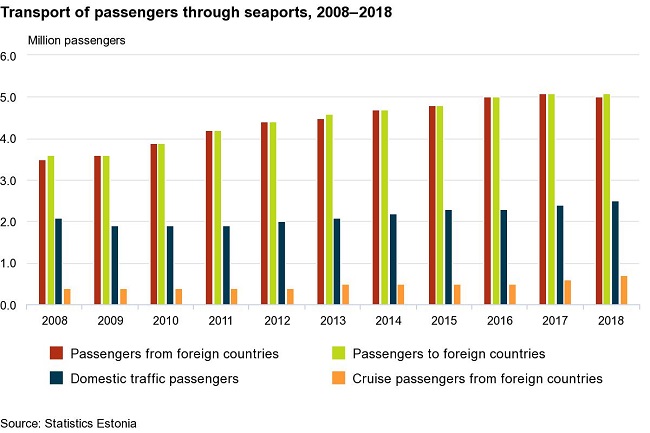Analytics, Estonia, Statistics, Transport
International Internet Magazine. Baltic States news & analytics
Sunday, 02.11.2025, 07:21
Passenger traffic on domestic ship routes increased in Estonia
 Print version
Print version On the main scheduled
domestic ship lines, around 2.5 mln passengers were transported, which is
67,400 passengers more than in 2017. On those routes, 471 more trips were made
than in 2017, i.e. over 16,600 trips. On domestic routes, approximately 1 mln
vehicles were served, i.e. over 52,100 more vehicles than in 2017. 71% of the
vehicles served on domestic ship routes were passenger cars and a fourth were
trucks and trailers.
Last year, approximately 10.7 mln passengers used the
services of Estonian ports in international sea traffic, which is somewhat less
than in 2017. The drop was mainly due to a decrease in the number of passengers
travelling between Estonia and Finland, where the number of passengers
transported reached 8.9 mln. Between Estonia and Sweden, 1.3 mln sea passengers
were transported, i.e. slightly less than the year before. On international
routes, more than 2 mln vehicles were served by ports in 2018; 71% were
passenger cars and 26% were trucks and trailers. In the cruise season from
April to October, 652,790 cruise passengers arrived by sea to Estonia, i.e. a
tenth more than the year before.
In 2018, Estonian ports handled 35.9 mln tonnes of cargo,
which is 1.1 mln tonnes more than the year before. 24.5 mln tonnes of goods
were loaded and 11.4 mln tonnes of goods were unloaded in Estonian ports in
2018. 4% more goods were loaded and 1% more goods were unloaded than in 2017.
Transit goods were loaded and unloaded in ports in the amount of 19.1 mln tonnes,
which is 7% more than in 2017. 14 mln tonnes of transit cargo were loaded and
5.1 mln tonnes unloaded in Estonian ports. The most frequently handled group of
transit goods in Estonian ports were refined petroleum products (12 mln tonnes),
the transport of which increased by 6% in a year. The loading and unloading of
chemicals and chemical products as transit goods amounted to 6 mln tonnes,
which is a fifth more than the year before. In addition to transit goods,
10.6 mln tonnes of goods were transported abroad through ports and 6.3 mln
tonnes of goods arrived in Estonian ports. Goods transported abroad through
ports were mainly a mixture of types of goods transported together (3.3 mln
tonnes) and forestry and logging products (nearly 2.5 mln tonnes). Goods that
arrived in Estonian ports included primarily a mixture of types of goods
transported together (3.2 mln tonnes) and products of mining and quarrying (1.4
mln tonnes). Sea container transportation through ports (expressed in TEUs)
increased by 5% compared to the previous year, amounting to 241,000 TEUs in
2018. Containers in the amount of more than 17,480 TEUs were shipped out of
Estonian ports, and containers arriving in Estonian ports amounted to 123,520 TEUs.
According to the Estonian Maritime Information System
(EMDE), in 2018, the largest number of ships arriving in Estonian ports from
foreign ports (9,322) were general cargo vessels (incl. ro-ro passenger ships).
Also 944 liquid bulk carriers, 295 container ships, 159 dry bulk carriers, 117
specialised carriers and 340 cruise ships arrived in Estonian ports from
foreign ports.









 «The Baltic Course» Is Sold and Stays in Business!
«The Baltic Course» Is Sold and Stays in Business!

